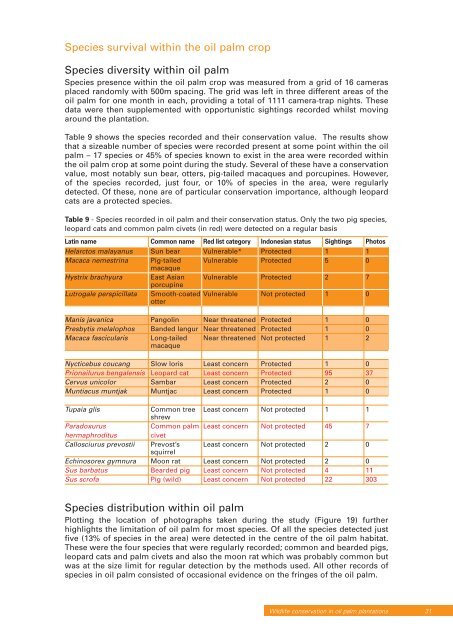The conservation of tigers and other wildlife in oil palm plantations
The conservation of tigers and other wildlife in oil palm plantations
The conservation of tigers and other wildlife in oil palm plantations
You also want an ePaper? Increase the reach of your titles
YUMPU automatically turns print PDFs into web optimized ePapers that Google loves.
Species survival with<strong>in</strong> the <strong>oil</strong> <strong>palm</strong> crop<br />
Species diversity with<strong>in</strong> <strong>oil</strong> <strong>palm</strong><br />
Species presence with<strong>in</strong> the <strong>oil</strong> <strong>palm</strong> crop was measured from a grid <strong>of</strong> 16 cameras<br />
placed r<strong>and</strong>omly with 500m spac<strong>in</strong>g. <strong>The</strong> grid was left <strong>in</strong> three different areas <strong>of</strong> the<br />
<strong>oil</strong> <strong>palm</strong> for one month <strong>in</strong> each, provid<strong>in</strong>g a total <strong>of</strong> 1111 camera-trap nights. <strong>The</strong>se<br />
data were then supplemented with opportunistic sight<strong>in</strong>gs recorded whilst mov<strong>in</strong>g<br />
around the plantation.<br />
Table 9 shows the species recorded <strong>and</strong> their <strong>conservation</strong> value. <strong>The</strong> results show<br />
that a sizeable number <strong>of</strong> species were recorded present at some po<strong>in</strong>t with<strong>in</strong> the <strong>oil</strong><br />
<strong>palm</strong> – 17 species or 45% <strong>of</strong> species known to exist <strong>in</strong> the area were recorded with<strong>in</strong><br />
the <strong>oil</strong> <strong>palm</strong> crop at some po<strong>in</strong>t dur<strong>in</strong>g the study. Several <strong>of</strong> these have a <strong>conservation</strong><br />
value, most notably sun bear, otters, pig-tailed macaques <strong>and</strong> porcup<strong>in</strong>es. However,<br />
<strong>of</strong> the species recorded, just four, or 10% <strong>of</strong> species <strong>in</strong> the area, were regularly<br />
detected. Of these, none are <strong>of</strong> particular <strong>conservation</strong> importance, although leopard<br />
cats are a protected species.<br />
Table 9 - Species recorded <strong>in</strong> <strong>oil</strong> <strong>palm</strong> <strong>and</strong> their <strong>conservation</strong> status. Only the two pig species,<br />
leopard cats <strong>and</strong> common <strong>palm</strong> civets (<strong>in</strong> red) were detected on a regular basis<br />
Lat<strong>in</strong> name Common name Red list category Indonesian status Sight<strong>in</strong>gs Photos<br />
Helarctos malayanus Sun bear Vulnerable* Protected 1 1<br />
Macaca nemestr<strong>in</strong>a Pig-tailed Vulnerable Protected 5 0<br />
macaque<br />
Hystrix brachyura East Asian Vulnerable Protected 2 7<br />
porcup<strong>in</strong>e<br />
Lutrogale perspicillata Smooth-coated Vulnerable Not protected 1 0<br />
otter<br />
Manis javanica Pangol<strong>in</strong> Near threatened Protected 1 0<br />
Presbytis melalophos B<strong>and</strong>ed langur Near threatened Protected 1 0<br />
Macaca fascicularis Long-tailed Near threatened Not protected 1 2<br />
macaque<br />
Nycticebus coucang Slow loris Least concern Protected 1 0<br />
Prionailurus bengalensis Leopard cat Least concern Protected 95 37<br />
Cervus unicolor Sambar Least concern Protected 2 0<br />
Muntiacus muntjak Muntjac Least concern Protected 1 0<br />
Tupaia glis Common tree Least concern Not protected 1 1<br />
shrew<br />
Paradoxurus Common <strong>palm</strong> Least concern Not protected 45 7<br />
hermaphroditus civet<br />
Callosciurus prevostii Prevost’s Least concern Not protected 2 0<br />
squirrel<br />
Ech<strong>in</strong>osorex gymnura Moon rat Least concern Not protected 2 0<br />
Sus barbatus Bearded pig Least concern Not protected 4 11<br />
Sus scr<strong>of</strong>a Pig (wild) Least concern Not protected 22 303<br />
Species distribution with<strong>in</strong> <strong>oil</strong> <strong>palm</strong><br />
Plott<strong>in</strong>g the location <strong>of</strong> photographs taken dur<strong>in</strong>g the study (Figure 19) further<br />
highlights the limitation <strong>of</strong> <strong>oil</strong> <strong>palm</strong> for most species. Of all the species detected just<br />
five (13% <strong>of</strong> species <strong>in</strong> the area) were detected <strong>in</strong> the centre <strong>of</strong> the <strong>oil</strong> <strong>palm</strong> habitat.<br />
<strong>The</strong>se were the four species that were regularly recorded; common <strong>and</strong> bearded pigs,<br />
leopard cats <strong>and</strong> <strong>palm</strong> civets <strong>and</strong> also the moon rat which was probably common but<br />
was at the size limit for regular detection by the methods used. All <strong>other</strong> records <strong>of</strong><br />
species <strong>in</strong> <strong>oil</strong> <strong>palm</strong> consisted <strong>of</strong> occasional evidence on the fr<strong>in</strong>ges <strong>of</strong> the <strong>oil</strong> <strong>palm</strong>.<br />
Wildlife <strong>conservation</strong> <strong>in</strong> <strong>oil</strong> <strong>palm</strong> <strong>plantations</strong> 31

















